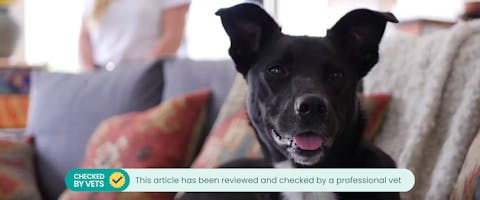Updated 22/05/2023
When you’re pet sitting, you don’t only want your new four-legged friend to be warm, safe and well-fed, you also want them to be as relaxed and happy as they can be. No matter how great a pet sitter you are and no matter how loving you’ll treat your new fur buddy, missing their owner and other stress factors might still make them a bit anxious – but never worry!
If your pooch protégé is feeling a little uneasy and you’re not sure how to calm a dog down, we’ve got you covered with this handy guide filled with pet sitting tips. So, keep calm and read on!
Trending posts
Purr-use some of the top blogs our members have been loving this month- Top male dog names for your new furry friendGot a new furry family member in your pack? Check…

- Top female dog names for your new fluffy palWelcoming a new pooch into your family? Explore…

- 250+ gray cat names your silver feline will loveRecently welcomed a fluffy gray bundle of joy into…

- What are normal pet sitting rates?Discover the average pet sitting rates for animals…

- Unique dog names to stand out from the packDare to be different with our list of the best…

Recognize the signs of dog anxiety
Before we’ll get into how to calm your dog down, let’s have a look at how to recognize anxiety in the pupper.
Signs of anxiety in dogs can be very clear or rather subtle, and depending on how well you know the dog in question, they can be easier or harder to identify. Some possible signs that are more obvious are:
- Hiding and/or cowering under furniture or in a corner
- Trying to run away
- Panting and/or shivering
- Urinating/defecating in the house
- Biting or destroying furniture
- Digging in flower pots, outside, or even on carpets and floors
- Excessive licking or chewing, often so much the area gets irritated
- Aggressive behaviour
- Loss of appetite
- Excessive drooling/hypersalivation
- Vocalization
There are also a few less obvious signs you can look out for, including:
- Pacing and general restlessness
- Avoiding eye contact
- Trying to lick your lips or hands (to appease you)
- Pushing you away/lifting their paw
- Visible whites of the eyes
- Barking or howling
- Repetitive/compulsive behaviour
If you notice several of these signs in the dog you’re sitting, it is likely it’s feeling anxious and will appreciate your help in relaxing. So, let’s have a look at how to calm an anxious dog.
Top tip: if you’re concerned about a pet’s behaviour while on a sit, don’t hesitate to reach out to the owner for advice. Remember, you can also speak to a team of 24/7 veterinary experts anytime while on a sit - just head to your member dashboard.
Tips for calming your dog’s anxiety
The best way to calm a dog really depends on how the pupper expresses anxiety and what exactly caused it in the first place. While some dogs will be anxious because they miss their owners, others will be anxious because they don’t know you yet, or because they suffer from general anxiety.
What helps to calm dogs down of course also depends on the dog’s personality. Some pooches love pets and cuddles, especially when they miss their owners, while others scare easily and would rather be left alone until they feel safe enough around you to approach you on their own. Therefore, the most important thing is to pay close attention to the dog’s reactions and what seems to calm them down or – on the other hand – makes them even more anxious.
But how to relax a dog? Here are some things you can try:
- Be calm and let the dog come to you: one mistake many people make when trying to calm dogs down is to forget that the best way to calm down a dog might be to simply do nothing at all. If your new dog friend is a little scared of you because it doesn’t yet know what to think of you, the best approach might be to just calmly sit down at the other end of the room and do something nice and relaxing, like reading a book. Once the pooch realizes you’re no threat, it might come to you, which is when you can start to let them sniff your hand and work your way up to gently petting them.
- Give them treats: depending on whether or not the owner allowed you to give the pupper some treats, you can also try and offer them something yummy to get on their good side.
- Pet and cuddle them: once the dog trusts you – or if they trusted you from the beginning – petting and cuddling might relieve a lot of stress. To be safe, don’t hug the dog or stoop down over it, but letting them push against your legs or even letting them climb into your lap are okay as long as you let the pooch take the lead.
- Give the dog a massage: if the dog visibly loves being touched, you can also try to give them a nice, gentle massage. Start by giving the pooch a good pet all over, then begin the actual massage on its neck and work your way down its back and towards its legs. There are great free demonstration videos on YouTube, if you’d like to check them out!
- Give them their favorite toys: playing with toys might take the pupper’s mind off being scared, lonely or stressed. If you really want to give them a treat, you might even bring a new toy as a little gift!
- Play some music or podcasts: loud music can stress some dogs, but some pooches actually really love music at low volumes. Try something calm first, like movie soundtracks or classical pieces. If you have Spotify, you can also try and play them special dog podcasts, developed in cooperation with dog experts and “designed to calm and reassure your dog”.
- Get plenty of exercise: what’s true for people is also true for dogs: exercise releases stress! So, unless your new four-legged friend is scared of leaving the house or going to the park, get out there, bring a few toys to play fetch with, and let them run wild for an hour or two at least a couple times a day.
- Practice commands: if going on walks isn’t enough for your dog, continue the play at home by practicing some commands with them or even teaching them something new. Dogs generally love to learn new tricks, especially if you give them little treats as a reward afterwards.
- Some dogs respond well to a calm coat or t-shirt: these apply constant pressure to the dog’s torso in a similar way that newborn babies are soothed by being swaddled. Of course, the pet parent would have had to have agreed to the purchase and tried it with the dog before the house sit takes place.
If you want to prepare for your pet sit beforehand, be sure to ask the owner if their pet often feels anxious, and for some top tips on how to relax your dog protégé – after all, they know them better than anyone and can surely give you some great pointers!
How to keep your dog calm during fireworks
Keeping dogs calm on normal days can be challenging, but it’s even more challenging to do so during fireworks. So how to calm down a puppy or a dog who isn’t used to loud noises on New Year’s Eve, July 4th or other traditional firework days?
- Prepare beforehand: by making sure your dog’s chip and info are up-to-date and make sure they can’t get out by locking all doors and gates.
- Stay inside: if you know when the fireworks will start, make sure to take a walk beforehand and don’t go out – or let the dog in the garden – once it begins.
- Provide them with a safe space: prepare a nice, safe place for your dog. This could be a dog bed with a blanket and toys, a pillow under the table or a soft blanket next to you on the couch or bed. Ensure they have access to this space 24/7. Making your dog feel as safe and comfortable as can be is key.
- Distract them: you can give them their favorite or a new toy, a chewing treat, play some music that will drown out the sounds, turn on the TV or play with the pooch – anything that will keep them occupied so they don't notice the noise.
- Shut the windows and close all blinds/curtains: fireworks aren’t only loud, they’re also bright, so try and shut them out as much as possible by not only keeping all windows closed but also by closing any blinds and curtains.
- Be calm: the more stressed you appear – even if you’re mostly stressed because you’re worried about the pupper – the more anxious your dog will be. If the dog sees you’re calm and unaffected by the fireworks, maybe even enjoying them, there is a good chance they will understand nothing bad is happening and relax, too.
By the way: if you’re wondering how to relax a dog during a storm or how to relax a dog during thunder, you can use the same tips as for fireworks!
While every dog reacts differently to stress, we hope that our little guide helped you learn more about how to recognize anxiety in your pooch protégé and how to calm down dogs when they’re stressed. If you’re looking for more great tips and techniques, be sure to head over to our Community Forum, where other pet-loving members will surely love to share their own experiences!
Meet our veterinary expert, Emma
This article has been checked by veterinarian Emma Chandley, BVetMed MRCVS PGCertSAS. Emma graduated from the Royal Vet College in London in 2011. She has a keen interest in surgery and went on to do a postgraduate certificate in small animal surgery and was then awarded advanced practitioner status in the same discipline.
Share your own tips with our pet-loving community
Do you have experience dealing with stressed dogs and therefore some great advice on how to relax an anxious dog you’d like to share? Awesome, cause we’d love to hear it! Our pet-loving community forum is full of caring pet owners who’ll happily learn from you or swap tips!

